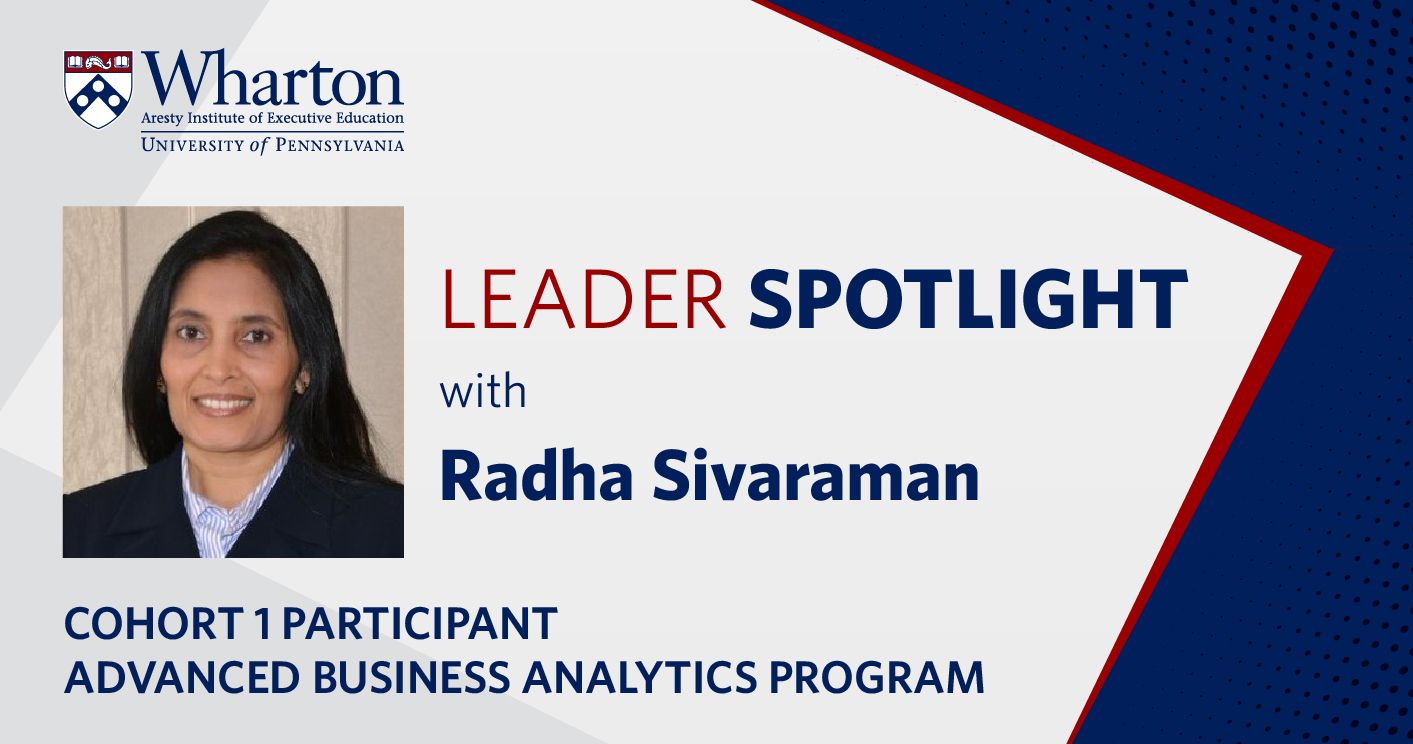Leader Spotlight: How Radha Sivaraman is transitioning from B2B to B2C with advanced business analytics


Having spent most of her career in the business-to-business (B2B) space, Radha Sivaraman is now pivoting to the business-to-consumer (B2C) side. Along with unprecedented levels of data now available, the possibility of extracting and monetizing valuable insights from them is the value differentiator. As someone from the science, technology, engineering, and mathematics (STEM) field, she is acutely aware of the power business analytics holds over the future.
With her experience working in large, global end-user and consulting services companies, Radha’s objective is to derive meaningful insights from data to make strategic business decisions. Through the Advanced Business Analytics Program, Sivaraman is confident of the elevation and positioning in her transition to the B2C business analytics sector.
Please tell us a bit about your educational background and career journey.
I graduated with a degree in math and completed my MBA before coming to the United States. At the beginning of my career, I was considering general management and even got a certification in organizational behavior from NTL in the U.S. With my math degree, there were many opportunities available in the field of computer science. That’s how I landed in the IT industry. I have been in the trenches and have led IT transformation projects from legacy systems to the current cutting-edge, innovative, and disruptive platforms. As part of my career progression, I held positions of increasing complexity and responsibilities managing global programs in diverse sectors such as financial services, manufacturing/automotive, health care, education, etc.
In what ways do you incorporate business analytics to drive product adoption and customer retention for your clients?
The first level was going from a legacy system to a digital system. Traditional industries had a lot of legacy applications and work that was cumbersome. So, to become agile and move on from a legacy mindset became imperative. That’s when digital transformation came in and offered seamless automation, productivity gains, streamlined processes, reliability, and enhanced user experience. Though there is an upfront investment in digital transformation, the tangible business benefits, customer satisfaction, and return on investment (ROI) is a compelling value proposition. It is a competitive advantage and a business differentiator that chief information officers can ignore at their own peril. Companies that design programs with a clear vision, followed by diligent execution can realize ROI in as little as six months to three years. It is important to think big, but start small.
The next level was going from digital transformation to analytics. While data was available, it was intuition-based inferences. Now, with analytics, companies can draw deeper and sharper insights from data. However, this journey wasn’t straightforward since the data was dispersed, disparate, and not structured for easy analysis. Bringing relevant data together and running algorithms to draw insights was a difficult journey. But the “holy grail” was the kind of data-driven insights you would get and the optimized decisions that could be made to drive higher business revenues and margins. Data is the new oil.
Incorporating business analytics also started driving transparency and equity and reduced the bias in decision making. This has helped companies think of the future. Typically, companies have been reactive to market demands, but with data-driven analytics, they can be proactive and predict customer and market behaviors. In turn, they can now experiment with minimum viable projects (MVP) or proof of concepts (PoV), let data drive actionable decisions, invest in the right areas, be profitable, and track the validity of decisions to make necessary course corrections.
As a woman, what are the challenges to approaching a male-heavy industry like business analytics? What advice would you give other women exploring business analytics?
Traditionally, B2B industries have been male-dominated. But now, the barriers to entry have been reduced. There is meritocracy; you must compete, and the opportunities are available. There may be some inherent biases against women. To remove those biases from data, especially in artificial intelligence and machine learning, using the right, relevant, and valid data is critical so that the analyses and interpretations help you make the right decision based on the merits of the case.
The glass ceiling for women, especially in IT, has already been broken, but you do have to “lean in”, take a stand, stick your neck out, and make your value seen, heard, and known. You have to compete with confidence and comfort so that you are valued for your contributions and not for gender alone. While the number of women leaders in the tech industry is rising, there are not nearly enough in the C-suite, and I see a day in the near future when that will be a reality.
What were you looking for in an executive program, and why did the Advanced Business Analytics Program appeal to you? I see that you had also taken up the Business Analytics: From Data to Insights program by Wharton Executive Education before this. Did that have a role in helping you decide?
The Business Analytics: From Data to Insights program, was somewhat technical and hands-on in nature that provided exposure to predictive and prescriptive analytics for decision making, using forecasting tools and techniques. Thereafter, I wanted to learn more from a broader business and strategy perspective on how data analytics could drive business transformation and digitalization journeys that are now critical to the success and viability of companies.
I found all of that in the Advanced Business Analytics Program. I gained firsthand knowledge of some data visualization tools, learned the importance of equitable governance structures, elimination of biases, ethical and legal considerations, the importance of human intuition to evaluate some AI/ML predictions, and how to leverage data insights to make competitive and differentiated decisions for organizations.
All these years, I’ve been in the automotive/manufacturing industry, which was primarily B2B. The B2C space is a whole different ball game altogether. It is extremely fast-paced. You have to constantly be innovative and deliver an excellent customer experience. The time between deploying technology-backed solutions and customer reaction is very small. You have to use data-driven insights for the best judgment on business impact, and a program like the Advanced Business Analytics Program helps you think in unorthodox ways and shift gears seamlessly. I could see early in the program cycle that this program will give me the elevation and positioning I was looking for and the value that I bring. It’s driven towards executive development and helped me to pivot from B2B to B2C.
Would you say that a background in STEM is essential to take up a business analytics program?
No, you don’t have to be from these backgrounds. I will not deny that it helps, but someone from a liberal arts background will not be at a disadvantage as long as they have an analytical bent of mind. Business analytics isn’t about running mathematical or statistical models but about understanding data insights to make business calls. You need to have an objective on the kind of insights you want to draw from the data. If you are not getting the insights you desired, you are perhaps not focusing on the right data inputs, or the right part of the data funnel, or feeding correct training data!
So, to get into a business analytics program, you don’t need to be from an engineering or math background; you need to have business acumen. This program isn’t about becoming a data scientist but about understanding the business impact of analytics.
What advice would you give others considering an executive education program?
There used to be a time when general executive MBA degrees were important. But I think that a focused, specialized executive education program has a huge advantage. If the program is focused on a discipline, it helps you dive deeper into that area and stand out when you are looking to grow in your career or change career paths; just as the Advanced Business Analytics Program is very focused on business analytics, you can apply that to anything.
In my opinion, undertaking executive programs focused on very specific areas are a shift in industry thinking. For many of my cohort peers, this has been a huge boon, and they acknowledge that pursuing this program has been of better value than an MS or MBA degree. I have personally been able to pivot to a global leadership role where I can directly leverage and apply learnings from the Advanced Business Analytics Program.
Talking about this program specifically, if you’re looking to pivot, this program is for you. From personal experience, I can say that you can make any shift by understanding how to use data, what to focus on, lead your teams to provide useful data-driven insights, and make a quantifiable impact for your organization.
You can learn more about the Advanced Business Analytics Program from Wharton Executive Education by visiting our program homepage.
This article first appeared on the Wharton Executive Education Advanced Business Analytics Program blog.




